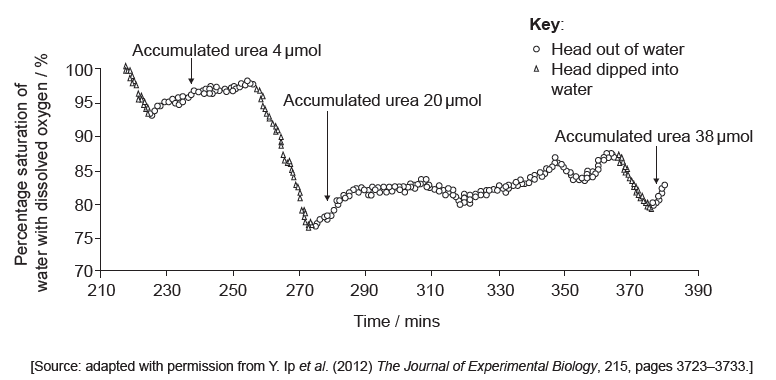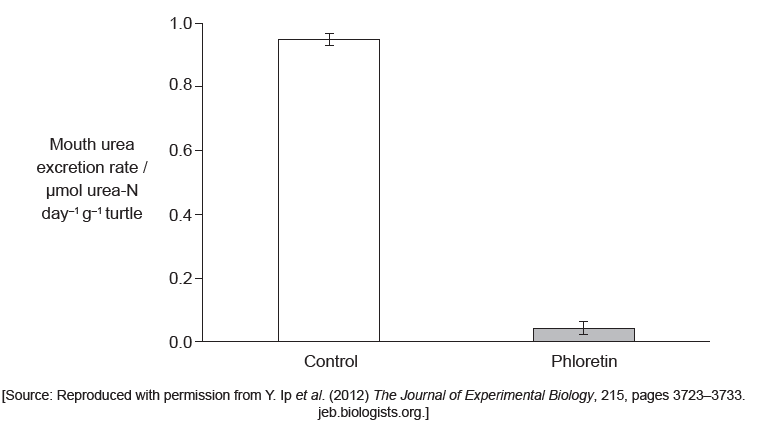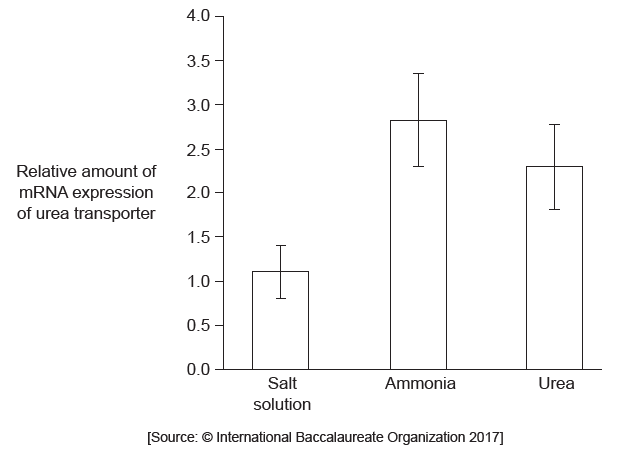Question
The Chinese soft-shelled turtle, Pelodiscus sinensis, lives in salt water marshes. The turtle can live under water and out of water.
These turtles have fully developed lungs and kidneys, however, many microvilli have been discovered in the mouth of P. sinensis. A study was undertaken to test the hypothesis that oxygen uptake and urea excretion can simultaneously occur in the mouth.
Initial experiments involved collecting nitrogen excretion data from P. sinensis. The turtle urinates both in water and out of water. When in water it allows waste products to be washed out of its mouth. When out of water it regularly dips its head into shallow water to wash its mouth. The table shows the mean rates of ammonia and urea excretion from the mouth and kidney over six days.

It was noted that during long periods out of water, turtles rhythmically moved their mouths to take in water from a shallow source and then discharge it. Changes in the dissolved oxygen and the quantity of accumulated urea in the rinse water discharged by the turtles were monitored over time as shown in this graph.

In order to test whether a urea transporter was present in the mouth tissues of the turtles, phloretin (a known inhibitor of membrane proteins that transport urea) was added to the water in which a further set of turtles submerged their heads. The results of that treatment are shown.

Further research was conducted to determine where mRNA expression of a urea transporter gene might be occurring in P. sinensis. Gel electrophoresis was used to analyse different tissue samples for mRNA activity.

Expression of the urea transporter gene by cells in the turtle’s mouth was assessed by measuring mRNA activity. Turtles were kept out of water for 24 hours and then injected with either a salt solution that matched the salt concentration of the turtle, dissolved ammonia or urea, followed by another 24 hours out of water.

Deduce whether the excretion of ammonia or urea changes more when a turtle emerges from water.
Compare and contrast the changes in urea excretion in the mouth with the changes in urea excretion in the kidney when a turtle emerges from the water.
Describe the trends shown by the graph for dissolved oxygen in water discharged from the mouth.
Suggest reasons for these trends in dissolved oxygen.
Deduce with a reason whether a urea transporter is present in the mouth of P. sinensis.
Outline the additional evidence provided by the gel electrophoresis results shown above.
Identify which of these turtle groups represent the control, giving a reason for your answer.
Suggest a reason for the greater expression of the gene for the urea transporter after an injection with dissolved ammonia than an injection of urea.
The salt marshes where these turtles live periodically dry up to small pools. Discuss the problems that this will cause for nitrogen excretion in the turtles and how their behaviour might overcome the problems.
▶️Answer/Explanation
Markscheme
a. urea
b. for both mouth and kidney
c. percentage change/change in μmol day−1 g−1 greater with urea/other acceptable numerical comparison
a. both higher/increased on emergence from/with turtle out of water
b. both increased by 0.66 «μmol−1 g−1 when turtle emerges from water»
c. % increase is higher in kidney / kidney 940% versus mouth 73/75% / increase is higher proportionately higher in kidney / kidney x10 versus mouth nearly double/x1.73
d. urea excretion by mouth greater than kidney out of water «despite larger % increase in kidney excretion»
decrease «when head is submerged» and increase when head is out of water
a. oxygen absorbed from water/exchanged for urea when head dipped in water«so oxygen concentration decreases»
b. lungs cannot be used with head in water / can «only» be used with head out of water
c. oxygen from water «in mouth» used in «aerobic cell» respiration
d. oxygen from air dissolves in water when head out of water «so oxygen concentration increases»
a. urea transporter is present
b. less urea «excreted»/ lower rate «of urea excretion» / excretion almost zero when phloretin/inhibitor was present
a. mRNA only in mouth and tongue/in mouth and tongue but not esophagus intestine kidney or bladder
b. bands / lines indicate mRNA for/expression of urea transporter gene
c. urea transporter gene expressed / urea transporters in mouth/tongue / not expressed/made in esophagus/intestine/kidneys/bladder
d. mRNA/transcription/gene expression/urea transporters higher in tongue/more in tongue «than mouth»
salt solution is control because it does not contain a nitrogenous/excretory waste product / it matches the salt concentration of the turtle / the turtle’s body already contains salt / because the turtle lives in salt water/salt marshes / because nothing has been altered
a. ammonia is «highly» toxic/harmful
b. ammonia is more toxic than urea/converse
c. ammonia converted to urea
d. urea concentration raised «by injecting ammonia»
e. difference between ammonia and urea «possibly» not «statistically» significant
Problems:
a. urea becomes more concentrated «in small pools» / lower concentration gradient «between tongue/mouth and water»
b. less water available for urine production/excretion by kidney
OR
less water in ponds for mouth rinsing/more competition for pools (to use for mouth rinsing)
Behaviour to overcome problems:
c. «still able to» dip mouth into/mouth rinse in water/pools
d. «still able to» excrete urea «though the mouth» in the small pools
e. more conversion of ammonia to urea/urea excretion rather than ammonia
f. more urea transporters/expression of urea transporter gene
g. urea excreted «in mouth/via microvilli» by active transport/using ATP
h. excretion with little/no loss of water
Question
Distinguish between autosomes and sex chromosomes in humans.
Describe the inheritance of hemophilia including an example using a Punnett grid.
Explain how meiosis results in an effectively infinite genetic variety of gametes.
▶️Answer/Explanation
Markscheme
X and Y chromosomes determine sex;
females XX and males XY;
X chromosome is larger than / carries more genes than the Y chromosome;
22 types/pairs of autosomes;
males and females have same types of autosomes;
sex-linked / due to gene on the X chromosome;
more common in males who only receive one X chromosome;
female is hemophilic if homozygous recessive / homozygous recessive normally fatal;
XH for dominant/normal allele and Xh for recessive/ hemophilia allele; (accept in Punnett grid/square)
example in Punnett grid/square with correct parental genotype and gametes;
correct genotypes of offspring;
correct phenotype ratio or percentage;

half the males are hemophilic and half of the females are carriers / OWTTE;
Allow marks for correct genotypes if the alleles are not shown superscript on an X, as long as the Y chromosome is indicated.
Do allow marking point d. if the letters for the dominant and recessive allele are not upper and lower case versions of the same letter.
one (homologous) chromosome is from the mother and one from the father;
homologous chromosomes pair (in prophase I);
crossing over/chiasma formation in prophase I;
recombination of linked genes / alleles/genes swapped;
many possible points of crossing over;
crossing over occurs at random positions;
due to crossing over the two chromatids of metaphase I chromosomes are not identical;
random orientation (of bivalents) in metaphase I;
in anaphase/at end of metaphase I chromosomes move to opposite poles;
independent assortment of chromosomes/genes;
2n/223 combinations (without considering crossing over);
four genetically different nuclei/gametes from each meiosis;
Accept any of the above points in a clearly annotated diagram.
Question
When performing dihybrid crosses with fruit flies (Drosophila), Morgan discovered that his results did not correspond to the expected Mendelian ratios. He explained this by suggesting that there is an exchange of genetic material between chromosomes. The image shows his diagram for three gene loci on a pair of homologous chromosomes during meiosis.

(a) Identify the stage of meiosis shown where exchange of genetic material occurs. [1]
(b) Explain the reason that Morgan’s results did not agree with expected Mendelian ratios in a dihybrid cross. [2]
▶️Answer/Explanation
a prophase 1/ first prophase;
b a. gene linkage/genes located on the same chromosome;
b. independent assortment does not occur;
c. no recombination unless there is crossing over (between the genes);
